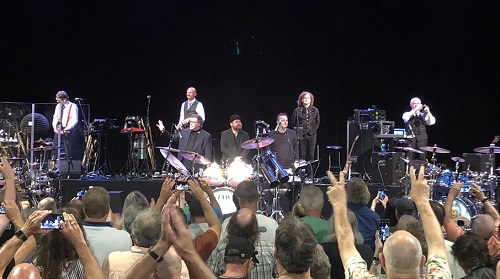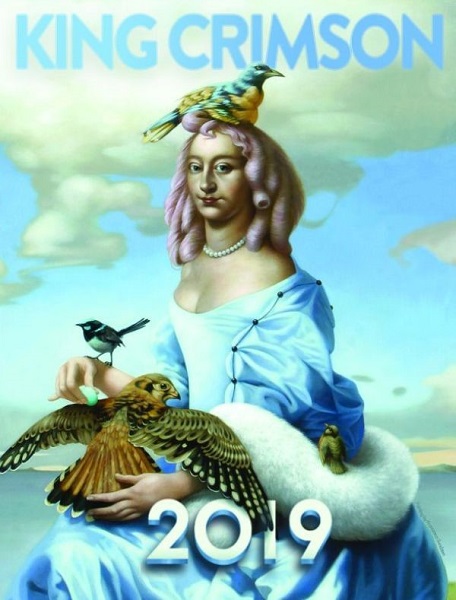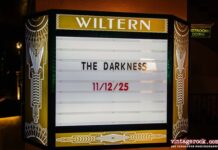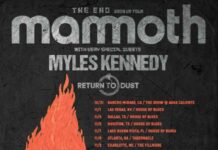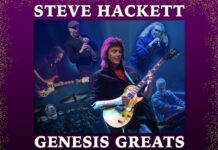An Observation by Shawn Perry
Subject to change at the whim of leader and guitarist Robert Fripp, the King Crimson live experience offers no simple explanation. Nor does it try. if you’re not prepared to wholly surrender your senses to a totally immersive plunge into the Crimson sphere, you’re at the wrong gig. The demand of your attention is so integral to a King Crimson performance that a no-photo policy is strictly enforced. That means audience members have to actually watch the show instead of photographing or filming it on a personal electronic device. Fripp suggests using “your eyes to video and your ears to hear.” A novel concept indeed. Yes, there’s something to be said about seeing a concert without some Martin Scorsese wannabe standing right in front of you with his arm extended and his phone trained on the stage for the entire night.
Before it got too dark and heavy, the three guitar players who call themselves California Guitar Trio came on. Paul Richards, Bert Lams, and Hideyo Moriya, each armed with an acoustic, spent the next 20 minutes warming up the audience — not an easy task when King Crimson is the headliner. Of course, it helps that CGT have a long-standing relationship with KC, having been part of Robert Fripp’s The League of Crafty Guitarists in the 90s. They even incorporate Fripp’s new standard tuning into their repertoire. The Greek was treated to a steady workout as the three magnificently orchestrated their parts to create fully realized instrumental versions of Johnny Smith’s “Walk, Don’t Run!,” The Chantays’ “Pipeline,” and Bach’s “Toccata and Fugue in D Minor.” It was a remarkable start for what can be described as a juggernaut of musicianship.
To reinforce the signs on the stage and screens, Fripp’s recorded announcement about the no-photo rule filtered out of the PA. He added that at the end of the show when super bassist Tony Levin pulled out his camera, the audience could then reach for their devices and capture a memory or two. Until then, everyone instinctively turned their focus on seven (usually eight with Bill Rieflan) impeccably dressed and well-mannered masters ready to push the capabilities of their chosen instrument to create a swirl of sonic electricity. Not a word was spoken, it just began — a sleight-of-hand, choreographed tuning session morphing into the wind and pitch of “Larks’ Tongues In Aspic, Pt. 1,” the first section of a multi-part instrumental spanning three decades. The fourth section and “Level Five,” which, according to Fripp, is actually the fifth section of the “Larks’ Tongues In Aspic” suite, were also included tonight.
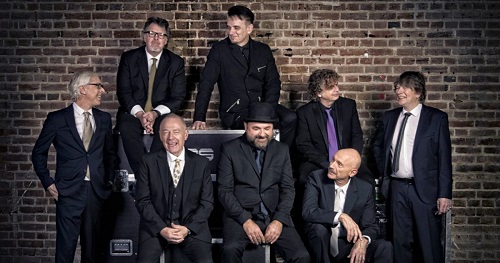
To the uninitiated, King Crimson may be construed as a spent force. To those in the know, they are a force to be reckoned with — especially with the triad of drummers out front, stationed behind imposing DW, TAMA and Sonor kits. Unlike other units with more than one drummer, there’s a fluid symmetry across the line, a quasi-scientific, agile approach to breaking down percussion notes into bite-size increments that Pat Mastelotto, Jeremy Stacey (who also plays keyboards), and Gavin Harrison gather up and spin into rich opulent tapestries of rhythmical patterns and tempos. Together, they are everything a single drummer wishes he could be — a six-armed, six-legged hexapus about to drive a tank through the audial cortex of your brain. They asserted their might in wondrous, spectacular ways.
It’s been with this lineup that any number of nuggets from the group’s formative years, covering 1969 to 1974, have popped up. For the 2019 tour, King Crimson celebrates their 50th anniversary, so “Epitaph,” a very haunting “Moonchild,” and the title track from the group’s 1969 debut In The Court Of The Crimson King were added in resolute fashion, edging out “I Talk To The Wind” and “21st Century Schizoid Man,” reserved for future shows perhaps. Though lead vocalist and guitarist Jakko Jakszyk sings in a completely different style than Greg Lake, John Wetton, or Adrian Belew, he firmly leaves his mark on their songs — likely at the behest of Fripp. The Gen X-ers may be confounded by Jakszyk’s interpretation of “Indiscipline,” but he definitely gives “Easy Money” an extra jolt that anyone can appreciate.
Following the selection process of the first album, “Pictures Of A City” was left out and “Cat Food” was brought in (they’re both from the second release, 1970’s In The Wake Of Poseidon). “Red” is pretty much a given, and tonight’s near-flawless execution must have locked in its continued presence on the list. After two solid sets, an air-tight encore of “Starless” finished off the full house without reservation. Fripp’s soaring guitar line carried it to the verses. Every line Jakszyk sang was trailed by Mel Collin’s incalculable horn. A little bit of creaking and a little bit of clicking grew into an all-hands-on-deck jam worthy of a standing ovation.
The members of King Crimson stood and bowed. As if on cue, Levin pulled out his camera and lined up a shot. Immediately, everyone raised up their phone, including yours truly, and tapped away. Not exactly a live action shot, but a nice token nonetheless. And there was Robert Fripp, the man who instituted the no-photo policy, snapping away with a camera of his own. The irony wasn’t lost on anyone, least of all Fripp, the last man to leave the stage as a surge of applause erupted. He has made it his life’s work to remain as capricious and compelled to sudden shifts in direction as possible. Only now he seems to be having more fun doing it.
